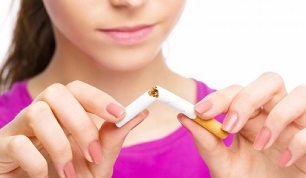
In the process of quitting bad habits, the main thing is not to overdo it with setting goals and updating goals. There are very few people who can quit smoking here once and for all. This is a long-term process with its own setbacks and experiences. It is all related to emotional, psychological and physiological characteristics. You can stop smoking on your own, but you have to do it correctly, reasonably, gradually.
Let’s try to address all the twists and turns in this important but not easy thing. Experts have developed a formula for success for a person leaving addiction in the form of a calendar or chart with a detailed description of the changes that occur in the body. I wonder what happens to the body when you stop smoking. Let's try to figure it out.
Important: consequences for the organism per day
During the transition to a healthy lifestyle, significant clinical changes occur in the body of an adult (heavy smoker), the emotional background and physiological state change. Each new day of smoking cessation differs from the previous one in terms of psychological problems and physical well-being. As they say, the main thing at this moment is not to break down. So, we will present a picture of what is happening in the form of a diary, in which a series of calendar days is recorded and a description of the current symptoms is given.
Smoking Cessation: Day One
When, finally, the decision to quit smoking is made finally and irrevocably (though not for the first time), it is necessary to gradually "enter" this process. To facilitate the transition from an unhealthy lifestyle to a healthy one, it is important to know how the body will behave. On the first day of the "course" of a healthy lifestyle, a weakened body should get used to the new regime for itself and start the recovery process. A sudden transition from one state to another can negatively affect overall well-being and reduce determination. This is not only a physical, but also a psychological test.
The main thing that happens to the body when you stop smoking: the amount of carbon monoxide decreases, the transport of red blood cells improves, more oxygen enters the tissues. Even from the outside, on the first day after quitting nicotine, the "former" smoker enjoys a new state for himself, is more active, more cheerful, confident in his strength. The very ability to painlessly quit the smoking habit on the first day of the course convinces the heavy smoker of determination and willpower. And this is important for overcoming the desire for nicotine.
However, remember that on the first day, characteristic physiological changes begin in the body.
For example, what happens in a woman's body:
- slight dizziness,
- lack of appetite,
- weakness,
- anxiety,
- sleep disorders,
- insomnia.

What's the reason? An experienced smoker subjects his body to tests on an emotional-psychological and physiological level. Such deep processes are triggered that the body “cannot live” without nicotine.
Quitting cigarettes triggers other dramatic changes. Nicotine is not easily absorbed into the bloodstream, but begins to affect blood flow. It is therefore important to consider that it will take the body at least a year to recover from quitting smoking. But for now, let’s get back to the smoking cessation diary.
Remember that on the first day of quitting smoking, characteristic physiological changes begin in the body, for example, women have a slight dizziness.
Smoking Cessation: Day Two
At this point, the determination may let you down a bit - the attacks will start to return to the old habit (at least not for long). This, for example, happens in the human body. While the fight takes place on an emotional level, no less dramatic changes occur in the body: the respiratory organs are released of mucus and components that are deposited, the functions of the ciliated epithelium are restored, the condition of the gastrointestinal tract improves, new cells appear in the tissues. The changes that occur during this period on an emotional level are manifested in the form of euphoria, emotional excitability. But irritability can also occur. It all depends on self-hypnosis and self-discipline. Although sometimes drowsiness can be abruptly replaced by energy. The second day after quitting, the appetite is not yet fully restored (strange taste sensations may occur). You may also experience shortness of breath, coughing, and even abdominal pain. During this period, urges to urinate and difficulty falling asleep are more common. If you add nervous tension to this, for example, as a result of stress at work, it is quite natural that your skin itches.
Smoking cessation: third and fourth day
Let’s consider further what happens to the body when you quit smoking. A set of factors affects how quickly the body will recover. A special role is played by the general condition and weakened immunity. Therefore, the nuances of smoking cessation therapy should be judged at the cellular level. Each person has their own supply of internal energy to fight addiction. Accordingly, an individual approach is required. In the cleansing process, the body gets rid of toxins. Even the cell structure changes to trigger radical cleansing.
This is what happens to the body today:
- regeneration of ciliated epithelium on respiratory tissues,
- in the pancreas the indicator of alkaline fractions increases,
- less mucus accumulates in the stomach,
- Blood circulation in the heart and brain generally improves.
A clear unwillingness to smoke begins to appear, peristalsis is normalized. At the same time, the "withdrawal" of the former smoker intensifies, which has more psychological implications, and nervousness appears. Quitting smoking seems to “find no place for itself, ” struggling with a long-standing habit. In this context, there is an increased appetite, "taking away" sweets. Sometimes the skin starts to peel and the fingers swell. When coughing, phlegm may appear in the throat.
Smoking Cessation: Day 5 and 6
In the process of “quitting” smoking, many people use a special table or calendar for convenience, someone keeps a diary and records their feelings in detail. This is useful when you need to recognize related symptoms and changes in the body. As it gets easier after a few days, a diary will help you refrain and analyze your mistakes. From the fifth to the seventh day, the ex-smoker notices the following changes in his body: it is noticeable that the microtraumas on the skin began to heal faster; all segments of the respiratory system are regenerating (even the most distant ones); digestion returns to normal; at an invisible level, blood cells are cleared of nicotine.

Usually the final point in the process of fighting addiction is set on the seventh day, when a person's physical addiction to cigarettes (smoke, smell) disappears. At the same time, there is no feeling of psychological discomfort. But don't forget about the probability of recurrence. Breaks happen anyway. When the euphoria passes, nervousness and aggression appear. Even sleep problems can recur. However, it is important to remember that this is not long, that the main phase in life - quitting smoking - is successfully completed and that there is no motivation to return to the old life.
In the process of "quitting" smoking, many people use a special table or calendar for convenience, someone keeps a diary and records their feelings in detail.
Smoking Cessation: Second Week
After a week, Rubicon seems to have been adopted and you can now live like a non-smoker, calmly dealing with everyday worries. But that rarely happens. The body must have made a big leap in the first week of smoking cessation. Nonetheless, sometimes even external factors (cigarette smoke and even their appearance, for example, when smoking nearby) can make a bad joke with an ex-smoker. Therefore, it is worth sharing your plans with friends and acquaintances, so as not to be tempted to break up "for company".
It's worth listening to your body at this point, you've probably already managed to get rid of nicotine. But this is not the end of the process of rebuilding the body from nicotine addiction. You can help yourself by flipping through the ex-smoker’s calendar, seeing obvious shifts in working on yourself. It turns out that, starting from the second week, the fight turns into a purely psychological level. The desire to smoke can occur during stress, sadness, at the sight of an active smoker at work. One should learn not to react to such external promises of going back in time.
What happens by the end of the second week?
It's been 14 days since the former smoker refrained from nicotine addiction. Then the following changes can be noticed in his body: healing of bronchitis and renewal of platelets. Although the recovery of red blood cells has not yet occurred. This may be due to vegetative-vascular manifestations. At the same time you can see how the complexion improves, the yellowish tint of the fingers disappears, and the acute cough gradually disappears. The longer the smoker experiences, the longer the symptoms will appear.
What happens in the first month of smoking cessation?
On the 30th day of giving up cigarettes, the weight starts to decrease, the system of the upper respiratory tract is completely restored and psychological comfort is felt. At the same time, enthusiasm can be replaced by depression or blues. Here, as in the first weeks, it is important not to get rid of it, to hold on, because the most difficult path of quitting smoking has already passed.
What happens from the second month of smoking cessation?
Starting from the second month of the nicotine addiction recovery process, and the next three to four months, the ex-smoker (this is especially noticeable in women) acquires more comfortable facial features, swelling subsides, grayish complexion disappears, as well as couperose nets. And in the third month there is an intense renewal of blood vessels in the body. This indicates that the body tone is finally returning to normal, and also that the "point of no return" has finally passed. The physical craving for tobacco has weakened so much that one can calmly spot another smoker next to him without experiencing the agony. In general, improvements are noticeable on an emotional, psychological, and physical level. A good appetite is no longer a sign of a stress attack, but is simply related to well-being.
What happens in the first year after quitting?
Let’s look now at what happens to the body when you quit smoking in the long run. Six months is an important milestone. At this stage of life, doctors notice a complete restoration of all body systems, when the blood and cells are almost completely released of toxic substances (nicotine). It seems easier to breathe every new day. The lungs really work more efficiently. A year is already a real experience of a former smoker. This is the period when the first serious results can be summarized. For example, you can congratulate yourself on the successful completion of the event and simply enjoy a life without nicotine, which will surely bear fruit. Those who quit smoking reduce their risk of heart attack and stroke by 30-50 percent; lung cancer - by 80 percent; gastrointestinal tract problems - by 70 percent.
Willpower or alternative
Many people who quit smoking have a false sense of how easy it is to achieve a goal by replacing one habit with another. But all psychoactive substances cause cravings for other addictions. Some switch to light cigarettes, some continue to smoke a pack of cigarettes, simply stretching it in time. Of course, smokers with twenty years of experience may find it harder than others. In this case, smoking cessation is cyclical, not sudden. In any case, only a person can be freed from freedom, giving up only one habit.























